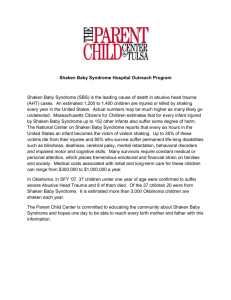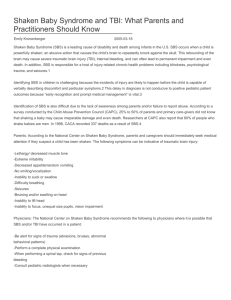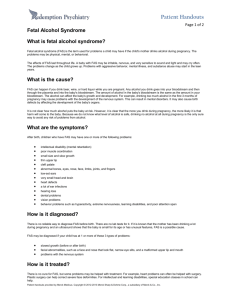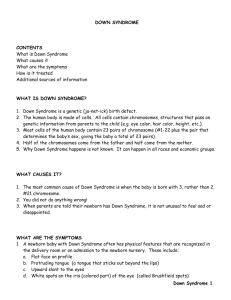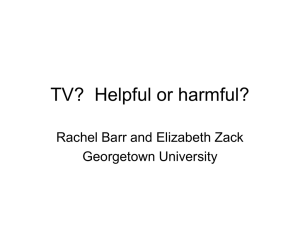Parenting Unit PPT
advertisement
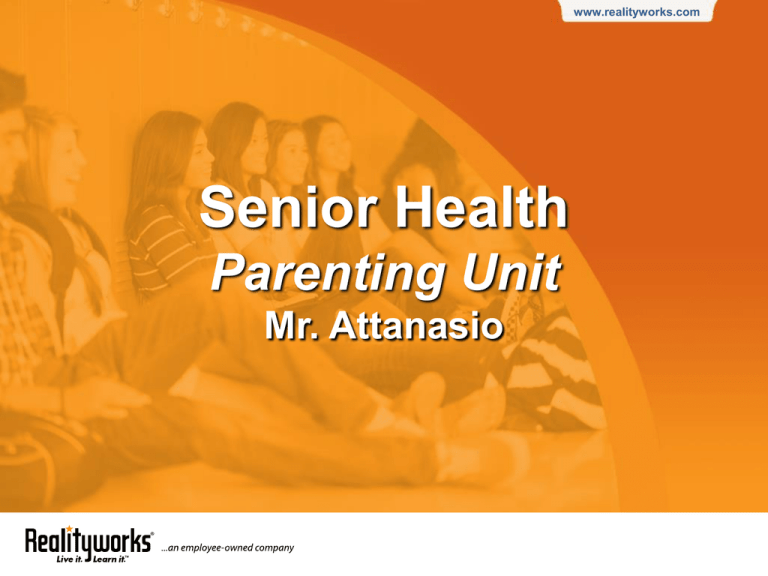
www.realityworks.com Senior Health Parenting Unit Mr. Attanasio www.realityworks.com Topics Covered: 1- RealCare Baby Project 2- Fetal Alcohol Syndrome 3- Sudden Infant Death Syndrome 4- Shaken Baby Syndrome 5- Child Safety www.realityworks.com 1- RealCare Baby Project www.realityworks.com RealCare Baby Project Overview: Why have a RealCare program? Review of Baby Project Packet Watch DVD and answer questions Practice with babies in Demo Mode www.realityworks.com Why Have a RealCare Program? 1. To give teens a realistic 24-hour experience in caring for an infant in a safe environment with meaningful evaluation and feedback. 2. To build character, teach responsibility, and encourage healthy babies, healthy families, and as a result, healthy communities. 3. To demonstrate the impact babies have on a person’s lifestyle, free time, extended family and future. www.realityworks.com On average, a U.S. teenager becomes pregnant every minute! Kost, K., Henshaw, S., & Carlin, L. (2014). U.S. Teenage Pregnancies, Births and Abortions: National and State Trends and Trends by Race and Ethnicity . Retrieved January 2010, from http://www.guttmacher.org/pubs/USTPtrends.pdf. www.realityworks.com Why Have a RealCare Program? 4. To help break the cycle of teenage pregnancy by demonstrating the consequences of teen sexual activity and early parenthood. 5. To provide hands-on education in infant care skills to help ensure proper care and handling and reduce the incidence of SIDS, SBS, and child abuse. www.realityworks.com www.realityworks.com Why Have a RealCare Program? 6. To increase awareness of the time commitment and constant, caring attention a baby needs, and the importance of having these skills before bringing a baby into the world. 7. To help expectant teen mothers work through important decisions regarding keeping their babies or giving them up for adoption. 8. To help at-risk individuals make better choices about sexual activity, alcohol use and other unhealthy behaviors that often lead to teen pregnancy, abortion, premature birth and unhealthy newborns. www.realityworks.com Children of adolescent mothers are twice as likely to be abused as those born to 20- or 21-year-olds. Hoffman, S.D., By the Numbers: The Public Costs of Adolescent Childbearing. 2006, The National Campaign to Prevent Teen Pregnancy Washington, DC. www.realityworks.com Why Have a RealCare Program? 9. To create a community of teens that is better prepared to make decisions about the timing of parenting that matches their personal and professional goals. 10. To help students make behavior decisions based on accurate information and from first hand experiential learning. www.realityworks.com Program Details What you need to know: • Every student gets to pick the date that they will take the baby out. • You may cancel and reschedule as you wish. Just know that the responsibility to schedule your parenting experience belongs to the student, not the teacher. • Every student must have a RealCare contract completed and signed by a parent or guardian, regardless of the age of the student prior to taking the baby. www.realityworks.com Program Details…continued What you need to know: • You must pass the baby project to pass the class and graduate. • If you have a failing grade due to mishandling, you will be given an assignment about child abuse to raise your grade to the passing level. • If you would like to redo the project for a new grade, you can reschedule at the end of the quarter, but that will not excuse you for doing the project about child abuse. www.realityworks.com Program Details…continued • Your grade will consist of two separate categories. – Your grade on the baby project, using a rubric that will be discussed in class. (300 pts) • See grading rubric in Baby Control Center – Your grade on this portfolio. (200 pts) Losing the portfolio will be a 20 point penalty. • Review packet together. . www.realityworks.com 2- Fetal Alcohol Syndrome www.realityworks.com Fetal Alcohol Syndrome Take pretest: FAS\Pretest.pdf Look at “Al” and ask students to write down things they notice about his appearance. www.realityworks.com Fetal Alcohol Syndrome Note the physical abnormalities: www.realityworks.com Fetal Alcohol Syndrome Note the physical abnormalities: www.realityworks.com Fetal Alcohol Syndrome Note the physical abnormalities INSIDE THE SKULL that we can’t see: www.realityworks.com Fetal Alcohol Syndrome When a mom drinks during specific times during pregnancy, it effects the areas that are being developed during that specific time. Here are some examples: www.realityworks.com Fetal Alcohol Syndrome • Watch the DVD on Fetal Alcohol Syndrome and complete the questionnaire. FAS\Posttest.pdf • Review answers together. FAS\Posttest Answers.pdf www.realityworks.com Fetal Alcohol Syndrome • 60% have trouble with the law • 50% will be confined in prison, mental institutions and/or treatment centers • 35% have alcohol and/or drug problems • 61% have a disrupted school experience • 49% exhibit inappropriate sexual behavior Other: joblessness, homelessness, inability to demonstrate effective caretaking and parenting, and increase potential for victimization, need for lifelong supervision www.realityworks.com Fetal Alcohol Syndrome • Video about teens and FAS – http://www.youtube.com/watch?v=moSY-8wGoPs www.realityworks.com 3- Sudden Infant Death Syndrome www.realityworks.com SIDS • Read article about SIDS • Answer questions about SIDS from your handouts. • Review together. www.realityworks.com SIDS • Video about teens and FAS – http://www.youtube.com/watch?v=moSY-8wGoPs www.realityworks.com www.realityworks.com www.realityworks.com 4- Shaken Baby Syndrome www.realityworks.com SBS • Read article about SBS • Answer questions about SBS from your handouts. • Review together. www.realityworks.com SBS • Video on SBS simulator • http://www.youtube.com/watch?v=THhFoYk7U40 www.realityworks.com Shaken Baby Syndrome • Of the estimated 3,000 children diagnosed with Shaken Baby Syndrome in the United States, 25 percent will die. • Almost 78 percent of survivors have neurodevelopmental abnormalities or sustain permanent lifelong disabilities. • There is a significant cost for the continuing medical and special educational needs of these children • SBS is rising with the recession. A study between 2007 and 2009 found a 65 percent increase. Article pictured at right Barlow KM, Thomas E, Minns RA. The neurological and neuropsychological outcome of non-accidental head injury. European Journal Of Paediatric Neurology; 3: 6:A139(Abstract). www.realityworks.com 5- Child Safety www.realityworks.com Child Safety Seats • Read the article about Child Safety Seats (the tether system) • Answer questions from your handouts. • Class discussion. www.realityworks.com Safe Car Temperatures • Turn to notes that cover Hypothermia and Hyperthermia • Click here: – Z:\2011-12 Sr Health\1-Baby Project\Temp Infants.ppsx
